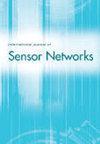分布式无线传感器网络的能量平衡无环路路由协议
IF 1.1
4区 计算机科学
Q4 COMPUTER SCIENCE, INFORMATION SYSTEMS
引用次数: 9
摘要
为了延长网络寿命,能量均衡路由算法基于节点深度、剩余能量和能量密度的加权和来构建路由。遗憾的是,该算法引入了路由环路和冗余跳数,导致端到端延迟,消耗更多的能量。更严重的是,数据包无法到达接收器。为了避免路由环路和冗余,本文提出了一种新的下一跳选择方法,并建立了路由环路和冗余跳检测与消除机制。理论分析和仿真实验表明,与最小跳数路由和能量均衡路由协议EBRP相比,该协议的网络寿命分别延长了68.72%和24.65%。本文章由计算机程序翻译,如有差异,请以英文原文为准。
An energy-balanced loop-free routing protocol for distributed wireless sensor networks
To prolong the network lifespan, the energy-balanced routing algorithm builds its routes based on a weighted sum of node's depth, residual energy and energy density. It is a pity that this algorithm introduces routing loops and redundant hops, which result in end-to-end delay and consuming more energy. More seriously, packets cannot reach the sink. In this paper, to avoid routing loop and redundancy, a novel next-hop selection method is proposed, moreover, the routing loop and redundant hops detection and elimination mechanism have been built up. Theoretical analysis and simulation experiments show that the network lifespan is stretched by 68.72% and 24.65% compared with minimum hop routing and energy-balanced routing protocol EBRP separately.
求助全文
通过发布文献求助,成功后即可免费获取论文全文。
去求助
来源期刊

International Journal of Sensor Networks
COMPUTER SCIENCE, INFORMATION SYSTEMS-TELECOMMUNICATIONS
CiteScore
2.40
自引率
27.30%
发文量
86
期刊介绍:
IJSNet proposes and fosters discussion on and dissemination of issues related to research and applications of distributed and wireless/wired sensor and actuator networks. Sensor networks is an interdisciplinary field including many fields such as wireless networks and communications, protocols, distributed algorithms, signal processing, embedded systems, and information management.
Topics covered include:
-Energy efficiency, energy efficient protocols-
Applications-
Location techniques, routing, medium access control-
Coverage, connectivity, longevity, scheduling, synchronisation-
Network resource management, network protocols, lightweight protocols-
Fault tolerance/diagnostics-
Foundations-
Data storage, query processing, system architectures, operating systems-
In-network processing and aggregation-
Learning of models from data-
Mobility-
Performance analysis-
Sensor tasking and control-
Security, privacy, data integrity-
Modelling of systems/physical environments, simulation tools/environments.
 求助内容:
求助内容: 应助结果提醒方式:
应助结果提醒方式:


